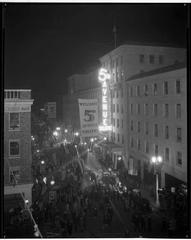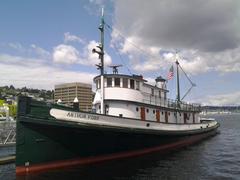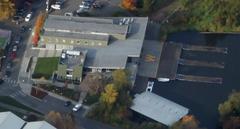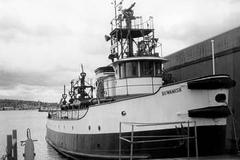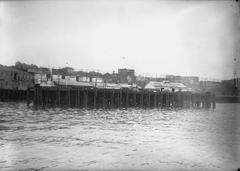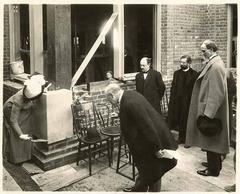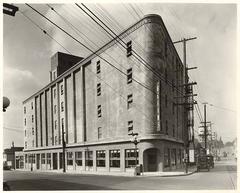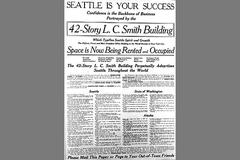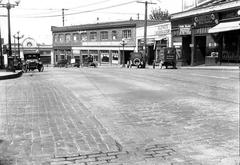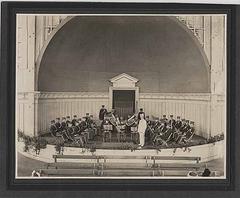Eagles Auditorium Seattle: Visiting Hours, Tickets, and Tour Guide
Date: 04/07/2025
Introduction
Nestled in downtown Seattle, the Eagles Auditorium is a celebrated testament to the city’s architectural grandeur, cultural vibrancy, and social history (Eagles Auditorium History). Established in 1925 as the headquarters for the Fraternal Order of Eagles (FOE) Seattle Aerie No. 1—the founding lodge of this influential organization—the Auditorium was designed by Henry Bittman and stands as a landmark example of early 20th-century terra cotta design (Historic Structures). Over the decades, it has served as a focal point for civic activism, legendary musical performances, and community gatherings, continually adapting to Seattle’s evolving urban landscape (Rock and Roll Roadmap).
Today, the Eagles Auditorium is operated by ACT Theatre, offering visitors a unique blend of historic ambiance and contemporary performance art (ACT Theatre Official Website). Its prime location near Pike Place Market, Pioneer Square, and the Washington State Convention Center makes it an essential destination for anyone interested in Seattle’s history and culture (Eagles Auditorium Seattle: History, Visiting Hours, Tickets & Nearby Attractions).
Table of Contents
- Early Foundations and Rise of the Eagles Auditorium
- Civic and Social Significance
- Musical Legacy
- Architectural and Urban Evolution
- Symbolism of the Eagle
- Integration with Seattle’s Historic Districts
- Visiting Hours, Tickets & Accessibility
- Travel Tips and Nearby Attractions
- Visual Gallery
- Frequently Asked Questions (FAQ)
- Preservation and Legacy
- Summary and Visitor Recommendations
- References and Further Reading
Early Foundations and Rise of the Eagles Auditorium
The Eagles Auditorium was conceived during a period of explosive growth in Seattle. The FOE, founded in 1898, quickly outgrew its original meeting space as membership soared. Seeking a grander headquarters, the organization commissioned Henry Bittman to design a seven-story, mixed-use structure at 7th Avenue and Union Street. This vision materialized in 1925 with the completion of a building that combined a 3,000-person auditorium, residential apartments, and commercial spaces—the first of its kind for the FOE (Eagles Auditorium History).
Civic and Social Significance
Throughout the 20th century, Eagles Auditorium played a pivotal role in Seattle’s civic life. It hosted union meetings, political rallies, community dances, and sporting events such as wrestling and boxing. During the Civil Rights era, it became a platform for transformative leaders including Martin Luther King Jr., Rosa Parks, and Mamie Till-Mobley (Eagles Auditorium History). Its adaptability made it a gathering place for Seattle’s diverse communities, reflecting the city’s evolving social fabric.
Musical Legacy
The Eagles Auditorium is renowned for its influence on Seattle’s music scene. In the 1950s, it was a hotspot for rhythm and blues; by the late 1960s and 1970s, it was a major venue for rock concerts, hosting legends such as Billie Holiday, The Doors, Fleetwood Mac, Janis Joplin, Pink Floyd, Ray Charles, and James Brown (Rock and Roll Roadmap; Concert Archives). Its open-floor design fostered unique, communal concert experiences. In the 1980s, it embraced punk and new wave, continually evolving with Seattle’s cultural scene.
Architectural and Urban Evolution
Henry Bittman’s design combined Renaissance Revival and early Art Deco elements with elaborate terra cotta ornamentation (Historic Structures). The building’s façade is distinguished by classical motifs and geometric patterns, while the interior features terrazzo flooring, marble wainscoting, a barrel-vaulted ceiling, and murals depicting eagles and Northwest scenes.
The auditorium’s surroundings have shifted dramatically over time, notably with the construction of Interstate 5 and the Washington State Convention Center. Despite urban changes, the building retained its historic character, undergoing adaptive reuse in the 1990s when ACT Theatre transformed it into a multi-theater performance venue (Eagles Auditorium History).
Symbolism of the Eagle
The eagle as a symbol resonates deeply in Seattle’s context. For the FOE, it embodied strength, freedom, and vision (BrainWiseMind: Eagle Symbolism). The eagle also holds immense significance for local Indigenous peoples as a spiritual messenger, further connecting the building to the region’s heritage (Visit Seattle). This symbolism is visible throughout the building, from the massive terra cotta eagle above the main entrance to interior murals.
Integration with Seattle’s Historic Districts
Eagles Auditorium stands among Seattle’s more than 450 designated landmarks and is closely tied to historic districts like Pioneer Square and Pike Place Market (Historic Seattle; TripJive: Seattle Landmarks). Its survival and adaptive reuse mirror the city’s broader commitment to honoring the past while fostering innovation and inclusivity.
Visiting Hours, Tickets & Accessibility
- Visiting Hours: The building operates primarily as a performance venue, with hours varying by event. For general visits or guided tours, check the ACT Theatre Official Website or contact the box office.
- Tickets: Purchase event tickets online, by phone, or at the box office. Prices vary by performance; discounts are often available for students, seniors, and groups.
- Accessibility: The venue offers wheelchair-accessible entrances, seating, and restrooms. Assistive listening devices and other accommodations are available. Contact the venue in advance for specific needs.
Special Events & Tours: Occasional guided tours and special events provide insights into the building’s history and architecture. Monitor ACT Theatre’s event calendar for updates.
Travel Tips and Nearby Attractions
- Getting There: Centrally located, the Auditorium is accessible via public transit (buses and light rail). Paid parking is available nearby.
- Nearby Attractions:
- Pike Place Market: Iconic open-air market with food, crafts, and entertainment.
- Museum of History and Industry (MOHAI): Learn about Seattle’s innovation and history.
- Pioneer Square: Historic district with galleries and landmark architecture.
- Freeway Park and Seattle Convention Center: Urban green space and events.
Visual Gallery
- Exterior view with terra cotta detailing
Alt: Eagles Auditorium Seattle terra cotta façade with large eagle sculpture at entrance. - Interior foyer with terrazzo flooring and murals
Alt: Eagles Auditorium grand lobby interior with Northwest-themed murals. - Main auditorium with high ceiling and stage
Alt: Eagles Auditorium interior showing stage and concert setup.
Frequently Asked Questions (FAQ)
Q: What are the Eagles Auditorium’s visiting hours?
A: Hours vary according to scheduled events. Check the ACT Theatre website or contact the box office for details.
Q: How do I purchase tickets?
A: Tickets are available online, by phone, and at the onsite box office.
Q: Is the venue accessible?
A: Yes, with wheelchair access and assistive listening devices. Contact ACT Theatre for specific accommodations.
Q: Are guided tours offered?
A: Occasionally, through ACT Theatre and local heritage organizations.
Q: Is parking available?
A: Paid parking is available in nearby lots and garages, but public transit is recommended during major events.
Preservation and Legacy
Eagles Auditorium is a Seattle city landmark and is listed on the National Register of Historic Places. Its ornate terra cotta façade and grand ceremonial spaces exemplify early 20th-century craftsmanship and vision (Historic Structures). Over the years, it has hosted the FOE, the Unity Church of Truth, and iconic rock concerts. Save for brief redevelopment threats, it has remained a vital part of Seattle’s social and cultural life, especially following its revitalization in the 1990s by ACT Theatre.
Summary and Visitor Recommendations
The Eagles Auditorium stands as a living monument to Seattle’s multifaceted heritage, uniquely embodying the city’s architectural innovation, cultural dynamism, and social progress (Eagles Auditorium History; Rock and Roll Roadmap). From its origins as the flagship lodge of the Fraternal Order of Eagles to its ongoing role as a vibrant performance venue, the building’s story is deeply intertwined with Seattle’s evolving identity. Its exquisite design and accessible location make it a must-visit for architecture enthusiasts, music fans, and history lovers alike (ACT Theatre Official Website; Visit Seattle).
When planning your visit, check for current events and ticket availability, and consider attending a performance or special guided tour for deeper engagement. Download the Audiala app for personalized recommendations and updates.
References and Further Reading
- Eagles Auditorium History, 2025, Eagles History Organization (http://eagleshistory.org/)
- Historic Structures, 2025, Historic Structures Website (https://www.historic-structures.com/wa/seattle/eagles-auditorium/)
- Rock and Roll Roadmap, 2025 (https://rockandrollroadmap.com/places/where-they-played/other-rock-music-venues/eagles-auditorium/)
- ACT Theatre Official Website, 2025 (https://acts.org/)
- Visit Seattle, 2025 (https://visitseattle.org/)
For more on Seattle’s historic sites and cultural venues, visit our website or download the Audiala app. Follow us on social media for event updates and visitor tips.




















